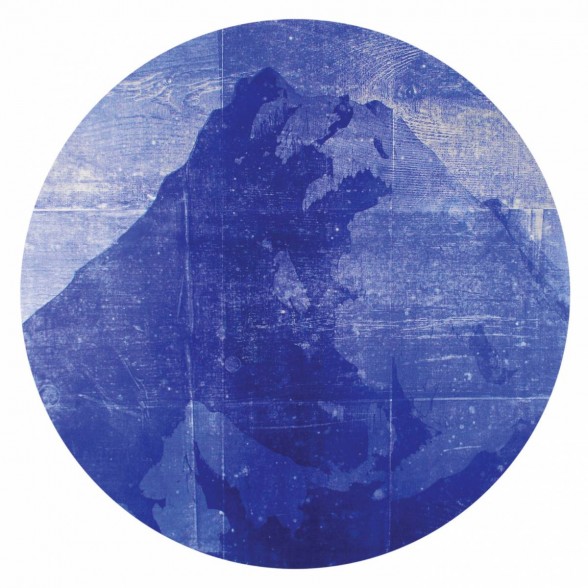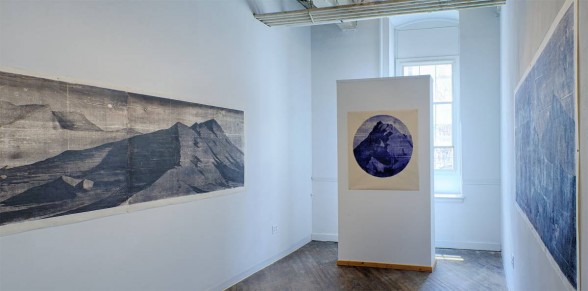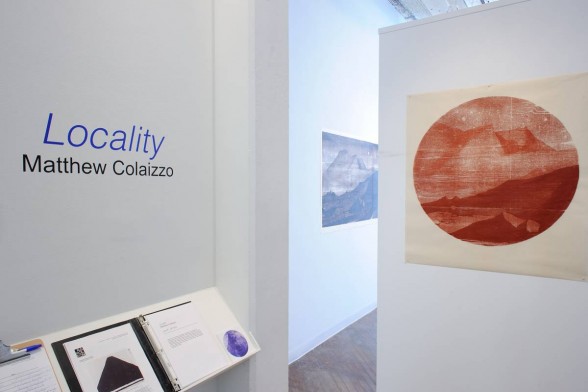[Noreen feels transported by a series of otherworldly, monochromatic woodblock prints. — the Artblog editors]
As a citydweller, it is easy to feel isolated from the forces of nature. A metropolis dislodges the city from the Earth. There is little grass to walk on, few trees to take shade under, and tall buildings suspend the sky far out of reach. The evidence of humanity’s touch is everywhere. Through this disconnect comes Locality, a solo show by Matthew Colaizzo, composed of a series of woodblock prints. Now on view at NAPOLEON, the exhibition continues the dialogue of many landscape artists in regard to human progress, and questions our role within nature.
Working into the wood

With this unique installation, NAPOLEON regulars will notice a change in the gallery’s setup. Two half-walls stand like monoliths in the central space, each hosting a circular print–one in front of the threshold, the other before the gallery’s back wall. A set of larger, rectangular prints settle on, to the right and the left side. The balanced arrangement brings an unusual rhythm to the space, like Morse code–one short, one long, one short, one long–in a never-ending circle. The prints themselves, all placid scenes of mountainous landscapes, seem to form one panorama, shown to the viewer in small glimpses, as in the circular prints; or long, quiet moments, as in the rectangular images.

Colaizzo makes his process an integral part of each piece. Created by a tedious, multi-woodblock printing process, the work of Locality embraces and utilizes the marks made by this process. The viewer will notice the evidence of the wood, from the gaps made by the edges of each block, to the idiosyncrasies of the grain. Pictured above on the left, “A Place on Earth (Gravel Piles)” transforms the blank spaces left by the wood’s knots into cosmic bodies in the landscape’s sky. The gaps in the ink that run horizontally and vertically across the piece feel like folds in a weathered map.
A sense of quiet disaster
In most of Western art history, printmakers have used their techniques for bookmaking, poster-making, and political cartoons, and have worked mainly in black and white. Colaizzo’s work bears a stronger resemblance to non-Western techniques, such as the colorful landscapes of late 19th-century Japanese prints. Like the work of old masters Ando Hiroshige and Hokusai, Locality captures the stillness and vastness of nature.

The viewer may recognize the images as landscapes, but they are nondescript, desert-like spaces. Through this uncertainty of place, I felt an uneasiness bubble to the surface of these seemingly docile works. As I examined the images closely, no foliage, rock formations, or landmarks identify this endless desert space. There is a sense of quiet disaster in the work–the grain of the wood resembles an atmosphere of settling dust, as if debris from a catastrophe has not yet cleared.
Inspired by the mounds of dirt and gravel the artist observed at construction sites, Locality captures the forces of nature within these artificial spaces. Though so much concrete and steel consume Philadelphia, these works remind me that natural forces still rule all human creation. The mountains of gravel that line construction sites are as much subject to erosion and gravity as the Appalachians are. It is within this construct that Locality rests–somewhere both beyond and within the forces of nature–and perpetuates the genre of landscape.
Locality is on view until June 25, 2015 at NAPOLEON. Gallery hours are Saturdays and Sundays 2 pm – 6 pm, or by appointment.









